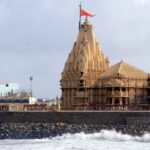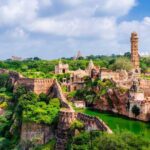Mahakaleshwar Temple is a famous Hindu temple situated in the old city of Ujjain, in the focal Indian province of Madhya Pradesh. It is regarded as one of the country’s most significant religious sites and draws a large number of devotees annually. The temple is believed to be one of the twelve Jyotirlingas, which are regarded as Lord Shiva’s most sacred abodes. It is dedicated to Lord Shiva, one of the principal deities in Hindu mythology. The Mahakaleshwar Temple is a popular tourist destination as well as a significant place of Hindu pilgrimage because of its impressive architecture, extensive history, and cultural significance.
Architecture and Design
The Mahakaleshwar Sanctuary complex is a noteworthy illustration of old Indian sanctuary engineering. It is implicit the Bhumija style, which is portrayed by its tall and slim pinnacles with a vertical bending shape, known as shikharas. The Mahakaleshwar Temple’s shikhara is adorned with intricate sculptures and carvings of various mythological and deity figures.
The mandapa, garbhagriha, and prakaram are some of the parts that make up the temple complex. The mandapa is the entry lobby to the sanctuary, which prompts the garbhagriha, the internal sanctum where the primary icon of Master Shiva is revered. The prakaram is a circumambulatory path that surrounds the garbhagriha and provides devotees with the opportunity to pray to the deity.

The sanctuary is made of stone and is intended to endure everyday hardship. Over the course of several centuries, the temple’s design and architecture have undergone a number of modifications, but it has managed to maintain its distinctive identity and charm. The sanctuary complex likewise includes a few more modest sanctums and designs devoted to different divinities, including Ganesh, Parvati, and Kartikeya.
The sanctuary’s inside is embellished with multifaceted carvings and models of different divinities and fanciful figures, which are a declaration to the rich social and imaginative practices of old India. The craftsmanship and ingenuity of the temple’s builders are evident in its architecture and design, which continues to awe and awe visitors to this day.
Religious Significance
The Mahakaleshwar Sanctuary is viewed as one of the most consecrated destinations for Hindus, particularly the individuals who love Ruler Shiva. It is thought to be one of the twelve Jyotirlingas, India’s most revered and significant temples to Lord Shiva. Devotees can connect with Lord Shiva and seek his blessings at the Jyotirlingas, which are regarded as powerful spiritual centers.
The Mahakaleshwar Temple is built on the spot where Lord Shiva appeared in the form of a lingam—a phallic symbol—to save the world from destruction, according to Hindu mythology. The lingam is said to have been so powerful that it broke into two pieces, one of which is buried in the Mahakaleshwar Temple and the other in the nearby Omkareshwar.

The temple’s religious significance is bolstered by the fact that it is linked to numerous myths and legends. King Chandrasena, who was cursed by a sage and had leprosy, is the subject of one such legend. He implored Master Shiva at the Mahakaleshwar Sanctuary and was relieved of his illness. He built the temple and dedicated it to Lord Shiva out of gratitude.
Additionally, the Mahakaleshwar Temple is a significant location for a number of Hindu festivals and rituals. The temple holds the annual Maha Shivaratri festival with a lot of enthusiasm, which draws a lot of devotees from all over India. Additionally, it is a well-liked location for the Rudrabhishekam, a special worship service to Lord Shiva.
In conclusion, the Mahakaleshwar Temple is regarded as one of India’s most sacred and powerful places of worship for Lord Shiva, which explains its immense religious significance. The sanctuary’s legends, stories, and celebrations add to its persona and draw enthusiasts from all over looking for favors and otherworldly comfort.
Visiting the Temple
If you want to go to the Mahakaleshwar Temple, the following information will be of use to you:
Timings: Several aartis (rituals) are performed throughout the day at the temple, which is open daily from 3:00 am to 11:00 pm. During special celebrations or events, the timings might change.
Limits and Charges: There is no section expense to visit the sanctuary, yet there might be charges for playing out specific ceremonies or contributions. Before entering the temple, devotees are required to adhere to the dress code and remove their shoes. Inside the temple, no cameras or cell phones are permitted.

How to reach: Ujjain is well-connected by road, rail, and air, and major Indian cities regularly offer bus and train services there. The closest air terminal is in Indore, which is around 60 km from Ujjain. In Ujjain, it’s easy to find local transportation options like taxis and auto-rickshaws.
Accommodation: There are many places to stay in Ujjain, from budget hotels to luxury resorts. It is advisable to make a reservation in advance, particularly during festivals and peak seasons.
Other Advice: Planning your visit ahead of time is recommended because the temple can get crowded, especially during festivals. Because there may not be many ATMs or card payment options in the temple area, it is also advisable to bring enough cash with you.
Due to its impressive architecture, long history, and religious significance, the Mahakaleshwar Temple can be a spiritual and cultural experience. The peaceful atmosphere of the temple and the sight of devotees praying can leave visitors with a lasting impression.
Surroundings and Attractions
The Mahakaleshwar Temple can be found in the ancient city of Ujjain, which has a rich cultural and religious history. Due to the presence of numerous significant temples and religious sites, it is also referred to as the “City of Temples.” In the vicinity of the Mahakaleshwar Temple, you can explore the following points of interest and attractions:
Kumbh Mela: One of the four cities that plays host to the Kumbh Mela, the world’s largest religious event, is Ujjain. Every twelve years, millions of devotees from all over India and abroad attend the Kumbh Mela.
Bade Ganeshji Ka Mandir: This temple is dedicated to Lord Ganesha and is near the Mahakaleshwar Temple. It is famous for having a huge idol of Lord Ganesha, which is one of the largest in India.
Kal Bhairav Temple: This sanctuary, devoted to Master Kal Bhairav, is situated close to the Mahakaleshwar Sanctuary and is known for its remarkable design and customs.

Ram Ghat: It is important to perform rituals and take a dip in the holy river at this ghat, which is on the Shipra River’s banks.
Vedha Shala: Built by Maharaja Jai Singh II, this observatory is known for its impressive instruments and structures. It is an important location for astronomical research.
Ashram of Sandipani: This ashram, situated on the edges of Ujjain, is accepted to be where Master Krishna and Sudama accepted their schooling. It is now a popular retreat location for yoga and meditation.
Mahakal Van: This woodland region, situated close to the Mahakaleshwar Sanctuary, is known for its normal magnificence and untamed life. It is a popular spot for bird watching and nature walks.
All in all, Ujjain and its encompassing regions offer a few attractions and spots of interest for guests. Whether you are keen on history, culture, religion, or nature, there is something for everybody to investigate and encounter around the Mahakaleshwar Sanctuary.
Conclusion
The Mahakaleshwar Temple is one of India’s most important and most revered temples, drawing millions of devotees annually. It is a must-visit location for anyone who is interested in Indian culture and religion due to its distinctive architecture, religious significance, and spiritual atmosphere. In addition to serving as a place of worship, the temple is a significant component of India’s and Ujjain’s cultural heritage. The Mahakaleshwar Temple is truly a destination that provides visitors with a one-of-a-kind and unforgettable experience. It has a fascinating history, a fascinating setting, and a variety of attractions and places of interest.
FAQs
What is the dress code for visiting the Mahakaleshwar Temple?
Before entering the temple, devotees are required to dress modestly and cover their heads. Men are expected to take off their shirts prior to entering the sanctuary’s inward sanctum.
Can women enter the inner sanctum of the temple?
Women are allowed to enter the temple’s inner sanctum, but they must cover their heads and wear traditional clothing.
What is the significance of the Bhasma Aarti at the Mahakaleshwar Temple?
At the Mahakaleshwar Temple, the Bhasma Aarti is a one-of-a-kind ceremony in which the deity is bathed in ash, which is believed to have healing and purifying properties. Before the temple opens for darshan on a daily basis, the ritual is performed.
Is photography allowed inside the temple premises?
Photography is not permitted within the temple grounds. Cameras and mobile phones must be left outside the temple by devotees.
What is the best time to visit the Mahakaleshwar Temple?
The best opportunity to visit the sanctuary is during the Mahashivaratri celebration, which generally falls in February or Walk. To avoid crowds, you should also go to the temple early in the morning or late at night.







